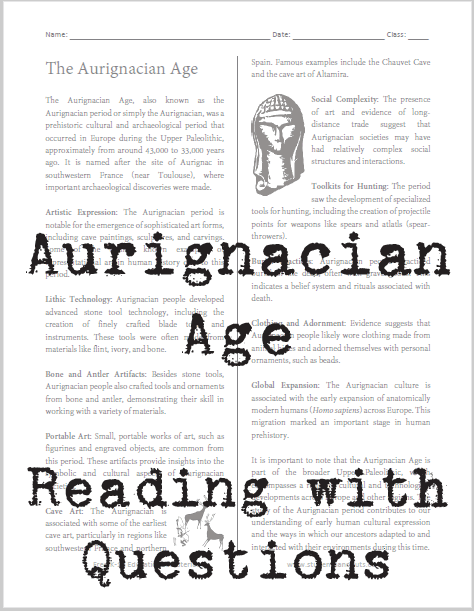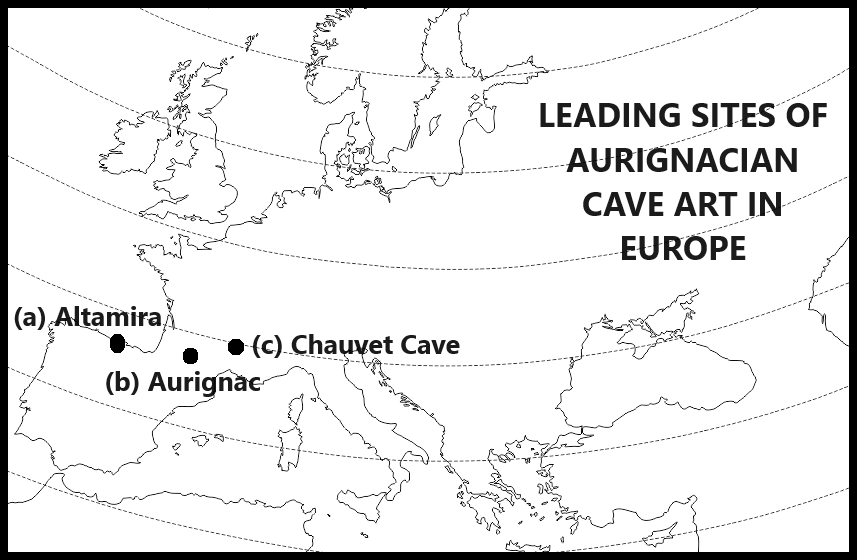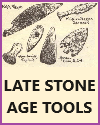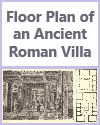| Aurignacian Age Reading with Questions |
|---|
| www.studenthandouts.com ↣ World History ↣ Early Humans ↣ Early Humans Worksheets |
 |
 |
|---|
|
Click here to print (PDF file). The answers are below. The Aurignacian Age, also known as the Aurignacian period or simply the Aurignacian, was a prehistoric cultural and archaeological period that occurred in Europe during the Upper Paleolithic, approximately from around 43,000 to 33,000 years ago. It is named after the site of Aurignac in southwestern France (near Toulouse), where important archaeological discoveries were made. Artistic Expression: The Aurignacian period is notable for the emergence of sophisticated art forms, including cave paintings, sculptures, and carvings. Some of the earliest known examples of representational art in human history date to this period. Lithic Technology: Aurignacian people developed advanced stone tool technology, including the creation of finely crafted blade tools and instruments. These tools were often made from materials like flint, ivory, and bone. Bone and Antler Artifacts: Besides stone tools, Aurignacian people also crafted tools and ornaments from bone and antler, demonstrating their skill in working with a variety of materials. Portable Art: Small, portable works of art, such as figurines and engraved objects, are common from this period. These artifacts provide insights into the symbolic and cultural aspects of Aurignacian societies. Cave Art: The Aurignacian is associated with some of the earliest cave art, particularly in regions like southwestern France and northern Spain. Famous examples include the Chauvet Cave and the cave art of Altamira. Social Complexity: The presence of art and evidence of long-distance trade suggest that Aurignacian societies may have had relatively complex social structures and interactions. Toolkits for Hunting: The period saw the development of specialized tools for hunting, including the creation of projectile points for weapons like spears and atlatls (spear-throwers). Burial Practices: Aurignacian people practiced burial of the dead, often with grave goods. This indicates a belief system and rituals associated with death. Clothing and Adornment: Evidence suggests that Aurignacian people likely wore clothing made from animal hides and adorned themselves with personal ornaments, such as beads. Global Expansion: The Aurignacian culture is associated with the early expansion of anatomically modern humans (Homo sapiens) across Europe. This migration marked an important stage in human prehistory. It is important to note that the Aurignacian Age is part of the broader Upper Paleolithic, which encompasses a range of cultural and technological developments across Europe and other regions. The study of the Aurignacian period contributes to our understanding of early human cultural expression and the ways in which our ancestors adapted to and interacted with their environments during this time. Answer the following questions based on the text, the map, and your knowledge of social studies. 1. On the map, identify (a) Altamira (in modern Spain), (b) Aurignac (near the border between modern France and Spain) and (c) Chauvet Cave (northwest of modern Marseille, France). 2. Aurignacian people developed bronze weapons. b. False 3. What is an atlatl? spear-thrower 4. What burial practice indicates a belief system? burial with grave goods 5. The Aurignacian Age is part of the broader Upper Paleolithic. 6. Imagine that you are an Aurignacian hunter. What might your typical day be like? Answers will vary. |
 |
| Early Humans Books and Films | Early Humans Outlines and PowerPoints |
| Early Humans Maps and Pictures | Early Humans Study Games |
| Early Humans Miscellany | Early Humans Worksheets |
| www.studenthandouts.com ↣ World History ↣ Early Humans ↣ Early Humans Worksheets |











